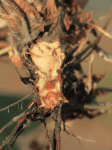May 30, 2022Lessons from Macrophomina in chickpea for strawberry growers
Gerald Holmes, director of the Strawberry Center at California Polytechnic State University, shares three takeaways from a study on Macrophomina in chickpea that can benefit strawberry growers.
See Holmes’ key takeaways below.
It’s helpful to look at similar systems to learn more about your own. For example, we can learn a lot about Macrophomina in strawberries by looking at the diseases this fungus causes in many other crops where it has been studied more intensively. A recent paper in the journal Plant Disease reviews dry root rot of chickpea (garbanzo bean) caused by M. phaseolina, the same pathogen that attacks strawberries.
I want to point out three things from this paper that shed light on our strawberry-Macrophomina pathosystem.


Drought promotes the disease
- Low soil moisture aggravates disease incidence and severity.
- Drought stress and high soil temperature increase plant root exudates, which increases colonization of the pathogen in plants.
- Low soil temperature reduces M. phaseolina microsclerotia germination efficiency and pathogen populations.
- Low soil temperature promotes the growth of antagonistic microbes.
- Reduction in root water potential increased lytic enzyme activities of M. phaseolina, which stimulated disease progression. Under drought, microsclerotia and first-order lateral roots in the topsoil experience more intense drought stress than roots in the subsoil. This explains the shedding of lateral roots in infected chickpea and how easily diseased plants can be uprooted.
High-temperature stress promotes the disease
- Relatively warm temperatures can increase the accumulation of certain secondary metabolites and enzymes.
- In the chickpea–Macrophomina pathosystem, disease incidence and severity were maximum at 35°C (95°F).
Soil physical properties influence disease
- Clay content and micronutrients such as potassium and organic carbon increase disease severity.
- Sandy loam soil can hold adequate air in its abundant macropores, thereby supporting microsclerotial germination, resulting in higher disease incidence than clay loam soil.
So what?
So, what we observe in strawberries is similar in chickpea. If we can reduce stresses due to temperature and soil moisture, we can reduce the disease. That may seem outside of our control, but plastic color and irrigation practices aimed at decreasing soil temperatures and improving soil moisture content and distribution could really help. Last year in our research plots we saw an 80% decrease in plant mortality compared to previous years. What was the difference? Two factors of particular interest: lower temperatures and improved soil moisture distribution. This year we are verifying this through field experiments. Stay tuned for results.
Reference
Rai, A. et al. 2022. Dry Root Rot of Chickpea: A Disease Favored by Drought. Plant Disease 106:346-356. https://doi.org/10.1094/PDIS-07-21-1410-FE
To see more from the Strawberry Center, visit https://strawberry.calpoly.edu.
Photo at top: Strawberry plant infected with Macrophomina phaseolina showing mostly necrotic foliage with a few remaining green leaves. Courtesy of Gerald Holmes















